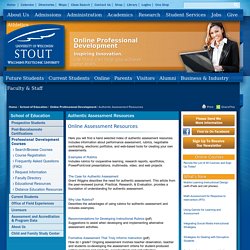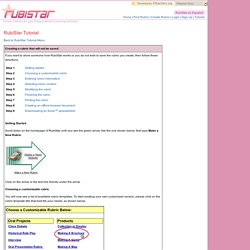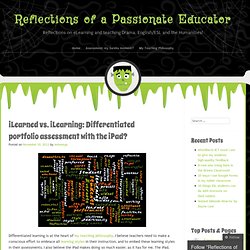

CLAAC : Les classes d'apprentissage actif. Classic: Exploring Rubrics. A little history: This article first appeared on the MiddleWeb site (with permission from the author) in 1997, in the early years of rubrics in the classroom.

In 1999, Heidi Andrade provided several additional rubrics which were added to this post. More than 15 years after this material first appeared at MiddleWeb and long after its original link was functional, it continues to be one of the most sought-after MiddleWeb resources. For that reason, we’ve reposted it here and redirected the original link to this new page. At the end of this post, we’ve also included links to several rubrics associated with inference, independent writing, and literary conversation. Please note that the portion of this post which was published at Educational Leadership can also be accessed at the ASCD site (4/20/14).
Authentic Assessment and Rubrics. Here you will find a hand selected index of authentic assessment resources.

Includes information about performance assessment, rubrics, negotiable contracting, electronic portfolios, and web-based tools for creating your own assessments. Examples of RubricsIncludes rubrics for cooperative learning, research reports, eportfolios, PowerPoint/oral presentations, multimedia, video, and web projects The Case for Authentic AssessmentGrant Wiggins describes the need for authentic assessment. This article from the peer-reviewed journal, Practical, Research, & Evaluation, provides a foundation of understanding for authentic assessment. Why Use Rubrics?
Recommendations for Developing Instructional Rubrics (pdf)Suggestions to assist when developing and implementing alternative assessment activities. Formative Assessment That Truly Informs Instruction (pdf)How do I grade? Creating a Rubric that will not be saved. If you want to show someone how RubiStar works or you do not wish to save the rubric you create, then follow these directions.

Getting Started Scroll down on the homepage of RubiStar until you see the green arrow, like the one shown below, that says Make a New Rubric. Click on the arrow or the text link directly under the arrow. Sight and Sound. Assessment and Rubrics. Alternative Assessment. Rubrics Whereas a checklist simply provides an indication of whether a specific criterion, characteristic, or behavior is present, a rubric provides a measure of quality of performance on the basis of established criteria.

Rubrics are often used with benchmarks or samples that serve as standards against which student performance is judged. Rubrics are primarily used for language tasks that involve some kind of oral or written production on the part of the student. It is possible to create a generic rubric that can be used with multiple speaking or writing tasks, but assessment is more accurate when the instructor uses rubrics that are fitted to the task and the goals of instruction. There are four main types of rubrics. 1. Holistic scales or rubrics respond to language performance as a whole. Holistic rubrics commonly have four or six points. A well-known example of a holistic scale is the American Council on the Teaching of Foreign Languages (ACTFL) Proficiency Guidelines (1986). 2.
iLearned vs. iLearning: Differentiated portfolio assessment with the iPad? Differentiated learning is at the heart of my teaching philosophy.

I believe teachers need to make a conscious effort to embrace all learning styles in their instruction, and to embed these learning styles in their assessments. I also believe the iPad makes doing so much easier, as it has for me. The iPad, and its enormous range of educational apps, offer multiple ways of teaching. Additionally, a very wide range of creation-apps means that students can create and produce content that suits and caters for their preferred learning style. Differentiation needs to be equally embedded in assessment as it is in teaching. I am a big fan of portfolio assessment. Planning : a huge variety of brainstorming and mind-mapping apps can be found in the App Store. While I have described my portfolio assessment practices in the drama classroom, along with my attempts to differentiate to cater for all learning styles, I believe such practices can be replicated in any other subject area.
Like this: Assessment: my Eureka moment? When I started teaching, I struggled most with assessment.

I found lesson-planning, curriculum-planning and classroom management challenging of course, but these were bearable challenges. Assessment, on the other hand, was a mystery to me. How do I genuinely assess student learning? How can I design meaningful, relevant and authentic assessment tasks that actually assess what they claim to? How can I be fair and consistent with my assessment of student work? During the early years of my teaching experience, I was always the teacher preparing students for assessments designed by someone else, whether it is an external organisation or another teacher.